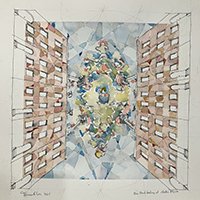Fernando Lara has kept an active artistic practice, closely related to his scholarship on Theorizing Space of the Americas.
Pine Street watercolor series
The Pine Street watercolor series explores my own positionality (Pine Street, Philadelphia) to explore spaces that are referential to me, with a strategy of balancing the abstract geometry of Philadelphia’s late 19th century row housing and the relational memories here materialized by the watercolor irregularity.
Outras habitabilidades
Other inhabitations
Museu Casa Kubitscheck, 2021
The work presented at the show “outras habitabilidades” was curated by Carlos Teixeira and Marconi Drummond, and comprised of an entire wall of popular modernist houses
Brazil is experiencing an environmental emergency. The Amazon and Cerrado are being burned to make room for more soy and more meat. The smoke from this burning darkened the afternoon in the city of São Paulo, 2000 miles away. In Minas Gerais, two mining tailings dams collapsed killing hundreds of people and entire river basins.
Thousands of acres covered in toxic mud.
Architecture and planning have yet to realize that they are an integral part of this perverse economy that destroys all kinds of life for quick profits. Each building the result of a process that begins with the extraction of clay, limestone, iron ore, silica and wood.
In the second semester of 2018 a group of 7 students from the University of Texas guided by Prof. Fernando Luiz Lara addressed the Mariana / Bento Rodrigues tragedy of November 5, 2015 when a tailings dam collapsed dumping 80 million cubic yards of toxic mud in the Rio Doce basin, killing 19 people and 300 miles of river life all the way to the Atlantic Ocean. We visited the site in October of 2018 and our studio generated design ideas to memorialize the disaster.
As part of the process, we looked into the relationship between architecture and the resource extraction industry that supply its materials. Students were asked to calculate the mineral content of various paradigmatic buildings and the impact of resource extraction on the territory.
Architecture and Resource Exploitation
XII Bienal de Arquitetura de São Paulo, 2019
The work presented at the 12th São Paulo Architecture Biennial shows four important Brazilian buildings, their axonometric drawings floating as ghosts over an aerial photo of the disaster are the day after the dam collapse. In bold letters, the volume of material and excavation required for the construction of each building. In front of the large board, 4 models built as concrete formwork were filled with mud from the disaster area.
The project followed a chronological order: in January the low-density pre-Columbian societies; in February pre-Columbian cities; in March the spaces of encounter and resistance against the European invasion after 1492; in April the Amerindian holocaust; in May the first European settlements; in June the disgrace of slavery; in June the colonial economy; in July colonial grid; in August the 18th century rebellions; in September the spaces of independence; in October the 19th century unequal modernization; in November the 20th century modernism and in December the more contemporary architecture.
365 Spaces of the Americas, 2018
During the year of 2018 I daily drew and posted on Instagram one space of the Americas. The idea was to call attention to how little we know about our own spaces given the overwhelming Eurocentrism of the discipline of architecture and urbanism.
250 Architectures of the Americas occupies an entire wall with that many ceramic pieces forming the map of the continent. Idealized by Prof. Fernando Lara, together with the Goma Oficina and manufactures by the students of the University of Texas at Austin and the Federal University of Minas Gerais, these ceramics represent the various architectural typologies of the continent: slums, trailer-homes, shotguns, row houses, suburbs, projects, skyscrapers. Buildings of mud, brick, concrete, wood and glass. Students drew over one hundred façades from all over the continent, abstracting the lines to fit the 5 × 7 cm template, and made the mold using a laser cutter. The pieces follow the proportions of the built environments of the Americas: 100 representing the informality of large cities (40%), 150 representing "market" solutions (55%) and 20 are paradigmatic architectures - the ones we learn in the books - here represented by the traditional glazing process of Cerâmica Saramenha, where the pieces were manufactures and fired.
250 Architectures of the Americas, XII Bienal de Arquitetura de São Paulo, 2017
The ceramic pieces were designed by Prof. Lara’s studio in 2017, manufactured at Cerâmica Saramenha with students from Texas, UFMG and Coletivo GOma, assembled at the XI São Paulo Bienal by Coletivo Goma and is currently assembled at the Copam apartment owned by Escola da Cidade and used by its guest professors.
This exhibition was designed to help visualize the complexity of writing a survey that adequately covers the myriad countries; the historical, social, and political conditions; and the scales of productions from small houses to urban plans.
The timeline and the projections allow the reader to simultaneously see the development of multiple and parallel historical strands and, at times, their interconnections and overlaps—to see, in short, the existing pluralities and that the history being presented within is provisional and interminable.
The Other of the Other, 2015-2018
UT Austin, Mebane Gallery March 2 – April 2, 2015; Fortaleza, FJAL, May 5-10 2015; Madrid, ETSAM, June 8-12 2015; Studio X Rio de Janeiro, July 2015; Florida Atlantic University, September 2015; Roger Williams University, September 2015; Universidad Autonoma Nuevo Leon, Monterrey, MX, September – December 2015; Universidad Michoacana San Miguel Hidalgo, Morelia, MX, November 2015; Universidade Federal de Santa Catarina, Florianópolis, February-March 2016; Museu da Cidade do Recife, April-May, 2016; João Pessoa, Instituto de Arquitetos do Brasil, July 21-August 30, 2016; University of Michigan Duderstatd Gallery, November 14-Dec 14, 2016; Universidad de La República, Montevideo, March 2-17, 2017; CEDODAL, Buenos Aires, April 9-15, 2017; Universidade Federal do Pará, Belém, May 2-19, 2017; Escola de Arquitetura da UFMG, Belo Horizonte, October 17-25, 2017.






